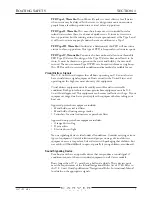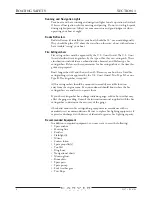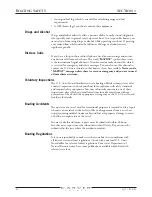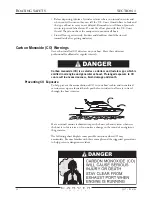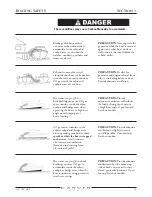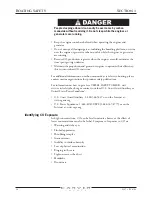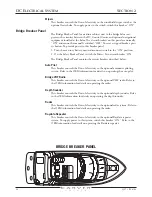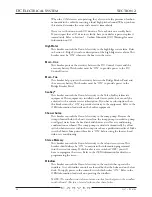
20
3327 • P2 6/06
DC ELECTRICAL SYSTEM
SECTION 2
While the batteries are relatively maintenance-free, there are a few things you
can do to increase their effectiveness and life:
• Keep your batteries fully charged. Batteries that are kept fully or near fully
charged last longer than batteries stored with a partial charge. The charge
level of the batteries can be monitored using the voltmeters on the helm
instrument panel.
• Inspect the batteries at least once every 30 days.
Disconnect the batteries before cleaning them.
• Periodically clean the battery terminals and cable connections. Remove any
accumulation of dirt on the top of the battery case. Use a wire brush to clean
the terminals. Coating the terminals with a terminal protecting product will
help reduce corrosion that can form in these areas.
• Check that the battery cables are securely attached to the terminal posts.
Tighten the terminal nuts ¼ turn beyond finger-tight using a wrench.
• Check the level of electrolyte in each cell of each battery. The correct level
is just above the plates. If the fluid level is low, add DISTILLED water only
until the electrolyte is at the correct level. DO NOT OVERFILL the cells.
• Remove the batteries from the boat during periods of extended storage. Store
your batteries in a cool (above freezing temperature), dry area. All batteries
lose some charge during storage, but the lower the temperature the less charge
is lost. Avoid storing the batteries in a humid place. Humidity causes the
terminals to corrode.
• Check the battery charge level every three months using a hydrometer or
voltmeter. If the specific gravity of the battery is less than 1.225 or the voltage
is less than 12.4 volts, charge the battery. Avoid overcharging the batteries.
Operating the 12-Volt Equipment
Power to your boat’s 12-volt equipment is controlled by circuit breakers and, in
most cases, individual controls for each piece of equipment.
Your boat contains three 12-volt circuit breaker panels:
• DC Control Center
• Bridge Breaker Panel
• Safety Breaker Panel
The circuit breakers on these panels enable you to control the electricity to
either the equipment itself or to the equipment’s controls by switching
the breakers “ON” or “OFF.” They also protect the electrical system by
automatically disconnecting the circuit from the power source in the event of
a short or overload. Power is supplied to these circuit breaker panels by the
accessory battery.
There are also thermal circuit breakers installed in many circuits to provide
added protection for components in those circuits. These circuit breakers are
located near the master disconnect switches.
Summary of Contents for 380 SPORT
Page 1: ...HIN CDR _________________ 380 Sport Owner s Guide 2007 Version 1 ...
Page 2: ......
Page 4: ......
Page 6: ......
Page 8: ......
Page 28: ......
Page 40: ...28 3327 P2 6 06 DC ELECTRICAL SYSTEM SECTION 2 DC SCHEMATIC 3327 324 002 5 12 7 05 ...
Page 54: ...42 3327 P2 6 06 AC ELECTRICAL SYSTEMS SECTION 3 AC SCHEMATIC 3327 300 015 2 9 04 ...
Page 108: ......
Page 122: ......
Page 124: ...112 3327 P2 6 06 WARRANTY AND PARTS SECTION 9 Hatches ...
Page 129: ...3327 P2 6 06 117 WARRANTY AND PARTS SECTION 9 Bill of Material ...
Page 130: ......
Page 131: ...3327 P2 6 06 119 WARRANTY AND PARTS SECTION 9 Carver Limited Warranty ...


